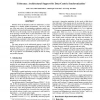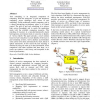154 search results - page 8 / 31 » Where Does Ubiquitous Computing Lead the Organization |
HPCA
2007
IEEE
14 years 8 months ago
2007
IEEE
With the advent of ubiquitous multi-core architectures, a major challenge is to simplify parallel programming. One way to tame one of the main sources of programming complexity, n...
SASO
2008
IEEE
14 years 2 months ago
2008
IEEE
—When programming a spatial computing medium such as a cellular automaton, the hop count distance to some set of sources (particles) is an often used information. In particular, ...
ICALP
2009
Springer
14 years 8 months ago
2009
Springer
We analyse the computational complexity of finding Nash equilibria in simple stochastic multiplayer games. We show that restricting the search space to equilibria whose payoffs fal...
ACSW
2006
13 years 9 months ago
2006
Task scheduling is an integrated component of computing. With the emergence of grid and ubiquitous computing, newer challenges have arisen in task scheduling. Unlike traditional p...
ECCV
2004
Springer
14 years 9 months ago
2004
Springer
Data association (obtaining correspondences) is a ubiquitous problem in computer vision. It appears when matching image features across multiple images, matching image features to ...


